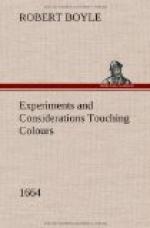EXPERIMENT III.
If pieces of White Harts-horn be with a competent degree of Fire distill’d in a Glass-retort, they will, after the avolation of the Flegm, Spirit, Volatile Salt, and the looser and lighter parts of the Oleagenous substance, remain behind of a Cole-black colour. And even Ivory it self being skilfully Burnt (how I am wont to do it, I have elsewhere set down) affords Painters one of the best and deepest Blacks they have, and yet in the Instance of distill’d Harts-horn, the operation being made in Glass-vessels carefully clos’d, it appears there is no Extraneous Black substance that Insinuates it self into White Harts-horn, and thereby makes it turn Black; but that the Whiteness is destroy’d, and the Blackness generated, only by a Change of Texture, made in the burnt Body, by the Recess of some parts and the Transposition of others. And though I remember not that in many Distillations of Harts-horn I ever sound the Cap. Mort. to pass from Black to a true Whiteness, whilst it continu’d in Clos’d vessels, yet having taken out the Cole-black fragments, and Calcin’d them in Open vessels, I could in few hours quite destroy that Blackness, & without sensibly changing their Bulk or Figure, reduce them to great Whiteness. So much do these two Colours depend upon the Disposition of the little parts, that the Bodies wherein they are to be met with do consist of. And we find, that if Whitewine Tartar, or even the white Crystalls of such Tartar be burnt without being truly Calcin’d, the Cap. Mortuum (as the Chymists call the more Fixt part) will be Black. But if you further continue the Calcination till you have perfectly Incinerated the Tartar, & kept it long enough in a Strong fire, the remaining Calx will be White. And so we see that not only other Vegetable substances, but even White woods, as the Hazel, will yield a Black Charcoal, and afterwards Whitish ashes; And so Animal substances naturally White, as Bones and Eggshels, will grow Black upon the being Burnt, and White again when they are perfectly Calcin’d.




